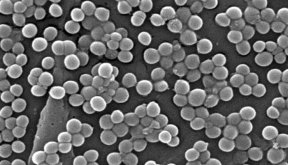Germ zapper
A compound found in nature kills certain bacteria in a new way.
By Emily Sohn
You’ve probably experienced the power of antibiotics. These amazing medicines kill the bacteria that give you strep throat and other infections. Usually, you start feeling better after a day or two of treatment.
Antibiotics have become so widely used, however, that many bacteria have developed ways to survive treatment. And when antibiotics stop working, sick people end up getting sicker. Tens of thousands of people die each year as a result.
 |
|
This microscope image shows clumps of Staphylococcus bacteria that are resistant to an antibiotic known as methicillin.
|
| Janice Carr, Centers for Disease Control and Prevention |
Now, scientists at Merck Research Laboratories in Rahway, N.J., may have found a new weapon against antibiotic-resistant bacteria. Lab tests in mice show that a compound called platensimycin attacks—and kills—certain bacteria in a new way.
Antibiotics were developed more than 50 years ago, and most types currently available work the same way as the early kind did. They attack bacteria cell walls. Or, they disable bacteria by knocking out the parts of the cell that make DNA and proteins.
Platensimycin takes a different approach. It attacks an enzyme that bacteria need to build and maintain membranes in their cells. Enzymes are types of proteins that make chemical reactions happen more quickly.
The neat thing about platensimycin is that it exists in nature. It is, in fact, the fourth natural compound found that targets the same enzyme. It’s also, by far, the most powerful of the four compounds.
“Nature is telling us again and again that if you want to go after bacteria, go after this enzyme,” says Charles O. Rock, a biochemist at St. Jude Children’s Research Hospital in Memphis, Tenn.
The Merck scientists found platensimycin by sorting through about 250,000 natural compounds. The search led to platensimycin, which is a small molecule made by a bacterium that lives in the soil in South Africa.
Scientists aren’t yet sure whether platensimycin will work as a drug in people. Still, the research is another example of how good nature can be at solving problems.—E. Sohn
Going Deeper:
Seppa, Nathan. 2006. Bug zapper: Novel drug kills resistant bacteria. Science News 169(May 20):307. Available at http://www.sciencenews.org/articles/20060520/fob1.asp .
To learn how antibiotics work and about resistance to antibiotics, go to science.howstuffworks.com/question88.htm and science.howstuffworks.com/question561.htm (How Stuff Works).







